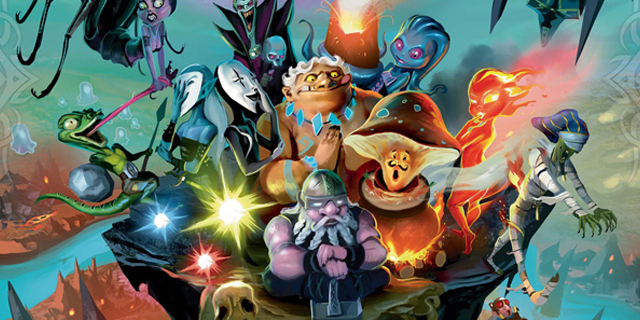
Philippe Keyaerts’s Small World was my favorite new game of 2009, with streamlined territorial conquest mechanics and a great mix-and-match fantasy theme. After a few expansions, Days of Wonder has released a new version of the game, Small World: Underground. Taking place in the dark subterranean realm beneath the normal Small World, Underground features the all-new races and powers that a fan of the original game might expect, as well as a couple of new twists.
The most noticeable new feature of Underground is the river. Running straight down the middle of the map, this watery multi-region terrain essentially bisects the board into two halves. Unlike the central lake and border oceans of the original maps, any player can cross the river by devoting one token to one of its regions and then continuing their conquests as normal, but no tokens can remain in the river when it comes time to redeploy troops. Deciding to cross the river (or not) can be an important strategic decision; doing so will temporarily cost you valuable troops, but might gain you access to specific regions that you want — or need — to conquer. Other regions on the board represent bottomless chasms. These spaces are impassable and further constrict movement options, effectively making Underground maps smaller than the originals (even though they have the same number of regions) and forcing more conflicts.
Underground‘s other additions are Righteous Relics and Popular Places. During setup, certain regions on the board are inhabited by two monster tokens (replacing the single Lost Tribe tokens from the original). When these monster-protected regions are first conquered, a random special tile is revealed that will represent either a magical artifact (Relic) or location (Place). These provide additional abilities to the players who controls them, which can often influence conquest decisions in interesting ways. Having fewer inhabited regions at the start of the game also allows for stronger starts, as fewer tokens are required to conquer regions. Finally, there are no icons on any of the regions other than those indicating the monster regions. There are still powers that award additional points (or other benefits) for occupying specific regions, but all it takes is a quick glance at the map to determine whether or not these are relevant — no more looking to see if tiles are covering any icons.
Other than these changes, Underground is still Small World and uses all of the same mechanics. While Underground is more than capable of standing on its own, the two games are also (mostly) compatible with each other, as are all of the expansions — although some power combinations don’t really work together and should be discarded if they crop up. Some other tweaks are required as well; a few are listed in the Underground manual, but a full list of them can be found (along with a FAQ) on the official Small World site.
Given the choice between the two, I prefer the improvements and aesthetics of Underground. The powers are generally more interesting, even though some are just recycled abilities from the original game but swapped to the opposite half of the race/power equation (e.g., the Elves’ inherent immortality is now a power available to any race in Underground). I find it unlikely that Underground can win over any gamers who weren’t fans of the original, but anyone who did enjoy Small World will probably appreciate the changes made.



















